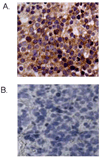MYCN, neuroblastoma and focal adhesion kinase (FAK)
- PMID: 21196322
- PMCID: PMC3171213
- DOI: 10.2741/e257
MYCN, neuroblastoma and focal adhesion kinase (FAK)
Abstract
Neuroblastoma is the most common extracranial solid tumor of childhood. This tumor is characterized by poor survival, especially when it features amplification of the MYCN oncogene. The ability for human cancers to propagate is marked by their ability to invade and metastasize to distant sites. Focal adhesion kinase (FAK) is a key tyrosine kinase involved in the survival and metastasis of a number of human tumor types. We have shown that FAK is present in human neuroblastoma and that its expression in neuroblastoma is related to the MYCN oncogene. We have also demonstrated that inhibition of FAK in neuroblastoma leads to decreased tumor cell survival. The current review addresses the relationship between the MYCN oncogene, focal adhesion kinase and neuroblastoma.
Figures




Similar articles
-
Inhibition of focal adhesion kinase decreases tumor growth in human neuroblastoma.Cell Cycle. 2010 Mar 1;9(5):1005-15. doi: 10.4161/cc.9.5.10936. Epub 2010 Mar 14. Cell Cycle. 2010. PMID: 20160475 Free PMC article.
-
The interaction between FAK, MYCN, p53 and Mdm2 in neuroblastoma.Anticancer Agents Med Chem. 2014 Jan;14(1):46-51. doi: 10.2174/18715206113136660331. Anticancer Agents Med Chem. 2014. PMID: 24041229 Review.
-
Targeting the MYCN effector, FAK, in neuroblastoma.Cell Cycle. 2010 Mar 15;9(6):1026. Epub 2010 Mar 15. Cell Cycle. 2010. PMID: 20410685 No abstract available.
-
Inhibition of focal adhesion kinase and src increases detachment and apoptosis in human neuroblastoma cell lines.Mol Carcinog. 2010 Mar;49(3):224-34. doi: 10.1002/mc.20592. Mol Carcinog. 2010. PMID: 19885861 Free PMC article.
-
The MYCN oncoprotein as a drug development target.Cancer Lett. 2003 Jul 18;197(1-2):125-30. doi: 10.1016/s0304-3835(03)00096-x. Cancer Lett. 2003. PMID: 12880971 Review.
Cited by
-
MycN promotes TRPM7 expression and cell migration in neuroblastoma through a process that involves polyamines.FEBS Open Bio. 2014 Oct 30;4:966-75. doi: 10.1016/j.fob.2014.10.012. eCollection 2014. FEBS Open Bio. 2014. PMID: 25426416 Free PMC article.
-
Copy Number Analysis Reveal Genetic Risks of Penile Cancer.Front Oncol. 2020 Dec 14;10:596261. doi: 10.3389/fonc.2020.596261. eCollection 2020. Front Oncol. 2020. PMID: 33381457 Free PMC article.
-
EZH2 inhibition decreases neuroblastoma proliferation and in vivo tumor growth.PLoS One. 2021 Mar 9;16(3):e0246244. doi: 10.1371/journal.pone.0246244. eCollection 2021. PLoS One. 2021. PMID: 33690617 Free PMC article.
References
-
- Packham G, Cleveland JL. C-myc and apoptosis. Biochim Biophys Acta. 1995;1242:11–28. - PubMed
-
- Murphy DM, Buckley PG, Bryan K, Das S, Alcock L, Foley NH, Prenter S, Bray I, Watters KM, Higgins D, Stallings RL. Global MYCN transcription factor binding analysis in neuroblastoma reveals association with distinct E-box motifs and regions of DNA hypermethylation. PLoS One. 2009 Dec 4;:e8154. - PMC - PubMed
-
- Negroni A, Scarpa S, Romeo A, Ferrari S, Modesti A, Raschella G. Decrease of proliferation rate and induction of differentiation by MYCN antisense DNA oligomer in a human neuroblastoma cell line. Cell Growth Diff. 1991;2 511518. - PubMed
Publication types
MeSH terms
Substances
Grants and funding
LinkOut - more resources
Full Text Sources
Medical
Miscellaneous

